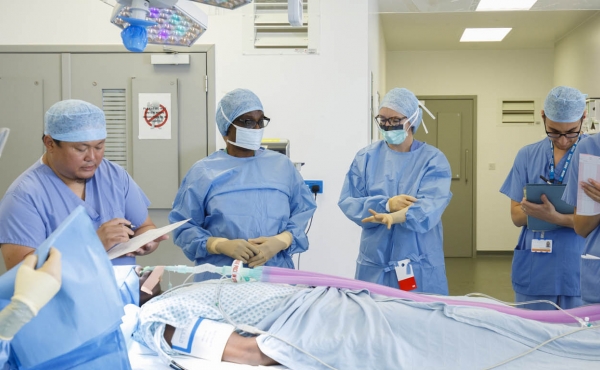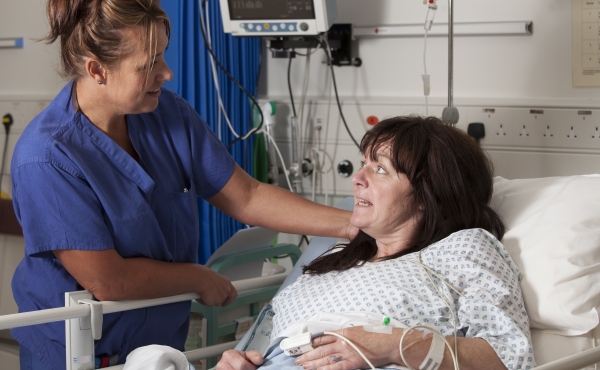Case Studies: Postoperative Phase
York Teaching Hospital NHS Foundation Trust
York hospital has one of the lowest resourced critical cares units in the country. Our aim was to establish a perioperative service which would use our scarce resources appropriately and reduce the reliance on critical care for major colorectal surgery. Secondary aims were to reduce complication rates and ensure coordinated care throughout a patient’s surgical journey.
“What we did”
All colorectal surgical patients over the age of 55 were including in this project. We standardised our pre-assessment pathway incorporating frailty indexes, cognitive, ARISCAT scoring (amongst others) along with traditional cardiopulmonary exercise testing (CPET). Patients were formally risk stratified to low (<1%), medium (3%) or high risk (9%) based on various CPET variables. Patients in the low risk group were allocated to a standard care pathway and would be nursed in the ward environment. Those in the medium group (i.e. patients whom would traditionally go to critical care post operatively) were to be treated on an “enhanced perioperative pathway” in a level one, nurse led unit with invasive flow monitoring and protocolised fluid and vasopressor management. High risk patients would continue to be treated on our critical care unit.
The medium risk patients had parameters set (mean arterial pressure, urine output and lactate) by the operative anaesthetist. In the event of these deteriorating ward nurses were empowered to assess for fluid responsiveness by utilising passive leg raises and looking for changes in dynamic stroke volume measurements. This would determine whether a fluid bolus or a vasopressor agent was administered. Safety features were built into the protocol whereby patients would be escalated to critical care if maximal treatment had been reached. This pathway was backed up by a perioperative nurse specialist and daily anaesthetic consultant cardiorespiratory led ward rounds.
Results:
We used a control group to compare our data with. Our medium length of stay (LOS) reduced from 8 to 6 days with our variation significantly reducing, with prolonged LOS (>12 days) reduced from 25% to 9%.
Planned critical care usage reduced from 43% to 16-17% with unplanned critical care LOS also reducing. Both our major and minor complication rates reduced and complications directly related to fluid administration significantly reduced. Although IV fluid use in theatre remained static, patients postoperative fluid balance was significantly improved with a reduction in almost 1.5 litres at 24 hours.
Lessons Learnt:
- High-risk patients can be successfully cared for in the ward environment (rather than Critical Care)
- Critical Care style, cardiorespiratory reviews for all are beneficial. It’s often the patient’s comorbidities rather than the actual surgery that leads to the mortality.
- A ‘champion’ is key – Perioperative Med Nurse Specialist/ Practitioner
- Data is king! Without baseline and detailed perioperative data it is very difficult to assess change. PQIP data useful to assess morbidity and patient factors e.g. DrEaMing etc.
- Ward nurses and surgical colleagues positive about presence of consultant anaesthetists on surgical ward.
Challenges:
- Education of nurses and surgeons to deliver care traditionally delivered in critical care required perioperative nurse specialist.
- Safety features of introducing arterial lines and vasopressors to the ward crucial.
- Encouraging standardisation of care in theatres for anaesthetists not regularly delivering colorectal lists.
- Perioperative medicine is not for everyone but for individuals looking for something new and different.
- The vast majority of this project is attention to detail, carrying out the basic tasks well and thoroughly and encouraging quality ward care.
- Continuing to fund the process after the initial project funds ceased. A business case was developed which was supported at senior exec level and this is now a fully funded service.
West Suffolk Hospital
At the West Suffolk Hospital the acute pain team appreciates the medical and social harm from prolonged use of post-operative analgesics. We are also aware of the dangers of drug driving. Furthermore, we recognise that compound preparations of analgesics hinder weaning off the analgesic medication. In addition, it is recognised that the paracetamol containing compound preparations have the intrinsic risk of inadvertent paracetamol overdose. In an effort to mitigate these risks and promote deprescribing the anaesthetic team has instigated the following strategies:
- Compound analgesics have been removed from Day Surgery.
- All surgical patients are given verbal and written instructions to aid post –operative deprescribing and are warned of the dangers of drug driving.
- All surgical patients are informed that it is expected that all new analgesics should be stopped within 2 weeks of surgery
- All patients newly prescribed oxycodone are warned about the addictiveness of the agent, and the need to consciously wean themselves off it.
- Minimal use of compound analgesic both in hospital and on discharge.
- The use of new in patient prescriptions of modified release oxycodone is heavily scrutinised by the surgical ward pharmacists, as it so difficult to wean off. Patients are given written guidance on weaning and the need to see their GP if further assistance is required
- Communication is on-going with the local Clinical Commissioning Group to promote deprescribing of chronic pain patients, who have had corrective surgery.
Do you have an example of great perioperative care?
Please get in touch and submit a Case Study submission so we can share it with the world!




